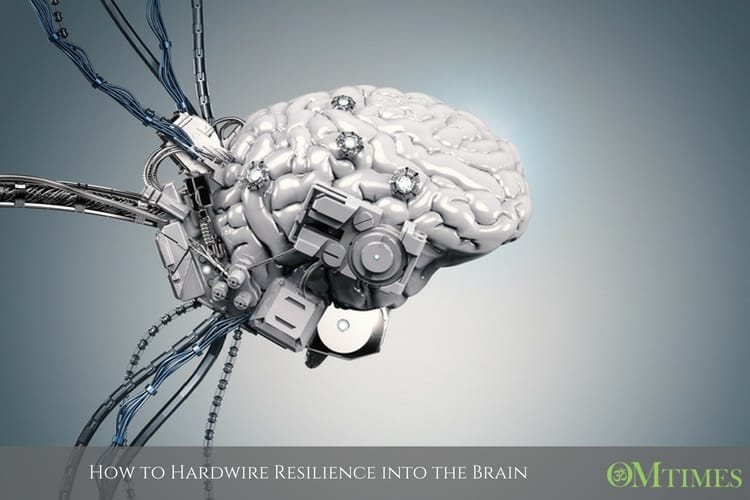How to Hardwire Resilience into the Brain

How is your resilience in rapidly changing situations?
Hardwire Resilience into Your Brain
by Rick Hanson with Forrest Hanson One winter, I went camping with my friend Bob in the backcountry near Sequoia National Park. After spending the day slogging uphill through deep snow, we were exhausted but needed to make camp.
One winter, I went camping with my friend Bob in the backcountry near Sequoia National Park. After spending the day slogging uphill through deep snow, we were exhausted but needed to make camp.
As the temperature rapidly dropped, Bob began shivering uncontrollably. He had poured out so much energy without refueling himself that he was sliding into hypothermia, the first stage of freezing to death. We hurried to set up the tent, get into our sleeping bags, light the stove, drink hot water, and eat hot food—and soon Bob’s teeth stopped chattering.
Luckily, we had just enough resilience to turn this misadventure around. Mental resources like calm, grit, and courage kept us going when we were hit with freezing temperatures. And these are the same types of resources we all can use to help us cope with and push through obstacles in our own lives.
But how do we cultivate them? The key is knowing how to turn passing experiences into lasting inner resources built into our brains. I teach this skill—called positive neuroplasticity—in my new book, Resilient: How to Grow an Unshakable Core of Calm, Strength, and Happiness (written with Forrest Hanson).
Though it’s not a quick fix, you can change your brain for the better by working it the same way you would work a muscle. As you become more resilient in the face of life’s challenges, you move toward greater well-being and away from stress, worry, frustration, and hurt.
12 Resources for Resilience
Every human being has three basic needs—safety, satisfaction, and connection—that are grounded in our ancient evolutionary history. While our circumstances have changed enormously over the last 200,000 years, our brains have remained largely the same. The neural machinery that enabled our ancestors to satisfy their need for safety by finding shelter, for satisfaction by getting food, and for connection by bonding with others is alive in our brains today.
A particular need is best met by inner strengths that are matched to it—and these mental resources are what gives us resilience.
To meet our need for safety, we can draw on:
- Compassion: Being sensitive to the burdens and suffering of others and ourselves, along with the desire to help with these if we can.
- Grit: Being doggedly tough and resourceful.
- Calm: Emotional balance and a sense of capability in the face of threats.
- Courage: Protecting and standing up for ourselves, including with others.
To meet our need for satisfaction, we can draw on:
- Mindfulness: Staying present in the moment as it is, rather than daydreaming, ruminating, or being distracted.
- Gratitude: Appreciating and feeling good about what already exists.
- Motivation: Pursuing opportunities in the face of challenges.
- Aspiration: Reaching for and achieving results that are important to us.
To meet our need for connection, we can draw on:
- Learning: Growing and developing, a process that allows us to cultivate all the other strengths.
- Confidence: Feeling a sense of being cared about, worthy, and self-assured.
- Intimacy: Opening to knowing and being known by others.
- Generosity: Giving to others through altruism, compassion, and forgiveness.
To start cultivating more resilience, pick a challenge in your life, and then consider the needs at stake in it, in terms of safety, satisfaction, and connection. You may be dealing with an external challenge, such as a relationship conflict, a stressful job, or a health problem. Or you could be facing an internal challenge, such as harsh self-criticism or feeling unwanted. Sometimes there’s a one-two punch. For example, tension with someone might be stirring up self-criticism inside you.
As you consider a major challenge and the need(s) at the heart of it, see if any of the twelve resilience resources stand out. Ask yourself:
- What, if it were more present in my mind these days, would really help?
- What inner strengths could help me stay peaceful, content, and loving when I’m dealing with this challenge?
- If this challenge began in the past, what would have been really helpful to have experienced back then?
- Deep down, what experience do I still very much long for?
The answers to these questions point to which resilience resources you might need to get through your challenge. Next, follow my HEAL framework (Have a beneficial experience, Enrich it, Absorb it, Link it) to cultivate this resource as a durable strength hardwired into your own brain.
Hardwiring Resilience – The HEAL Framework
Have a beneficial experience
Nearly everyone has many enjoyable or useful experiences each day, most of them mild and brief. For example, it feels good to put on a sweater if you’re chilled or feel friendly toward someone who is kind to you. But do you take notice of these experiences and highlight them in your awareness, or just pass by them and move on to the next thing?
The brain is continually remodeling itself as you learn from your experiences. When you repeatedly stimulate a “circuit” in the brain, you strengthen it. The brain operates so rapidly—with neurons routinely firing 5-50 times a second—that you can grow resilience and well-being many times a day, taking a minute or less each time.
To have beneficial experiences in the first place, it helps to be alert to the good facts around you—for example, fortunate circumstances, the beauty of nature, tasks you are completing, people who care about you, or your own talents and skills. You can even find the good in hard times, such as seeing the kindness of others as you go through a loss.
Besides simply noticing useful or pleasurable thoughts, feelings, or sensations that are already present in your awareness, you could create beneficial experiences, such as by getting some exercise (to help build the resource of grit) or deliberately recognizing your own good heart (for confidence). Or you could make something good happen in a relationship, such as by listening carefully to someone (for intimacy).
Over time, you can learn to directly evoke a positive experience, such as relaxing at will, calling up a sense of determination, or letting go of resentment. Because of experience-dependent neuroplasticity, repeatedly having and internalizing a particular experience in the past makes it easier and easier to evoke it in the present. It’s like being able to push a button on your inner jukebox and quickly get the song of a useful experience playing in your mind, since you’ve recorded it again and again.
To grow the inner resources that produce resilient well-being, we must turn experiences of these resources into physical changes in the nervous system. Otherwise, by definition, there is no healing, no growth, no development. Having an experience is only the first stage in the process of learning (including the emotional, social, and somatic learning I’m focused on here). The necessary second stage is to install that experience as a lasting change of neural structure or function. This is the stage that is routinely overlooked in psychotherapy, coaching, human resources training, and informal personal efforts at healing and growth. Therefore, this stage is where we have the greatest opportunity for steepening the learning curves of ourselves and others.
We can increase the installation of our beneficial experiences in two kinds of ways. First, we can enrich them, making them prominent and sustained in awareness. Second, we can absorb them by heightening the sensitivity of the nervous system. Here’s how.
Enrich it
There are five ways to enrich an experience:
- Lengthen it. Stay with it for five, ten, or more seconds. The longer that neurons fire together, the more they tend to wire together. Protect the experience from distractions, focus on it, and come back to it if your mind wanders.
- Intensify it. Open to it and let it be big in your mind. Turn up the volume by breathing more fully or getting a little excited.
- Expand it. Notice other elements of the experience. For example, if you’re having a useful thought, look for related sensations or emotions.
- Freshen it. The brain is a novelty detector, designed to learn from what’s new or unexpected. Look for what’s interesting or surprising about an experience. Imagine that you are having it for the very first time.
- Value it. We learn from what is personally relevant. Be aware of why the experience is important to you, why it matters, and how it could help you.
Any one of these methods will increase the impact of an experience, and the more, the better. But you don’t have to use all of them every time. Often, you’ll simply stay with something for a breath or two while feeling it in your body, and then move on to the next experience.
OMTimes Magazine is one of the leading on-line content providers of positivity, wellness and personal empowerment. OMTimes Magazine - Co-Creating a More Conscious Reality








